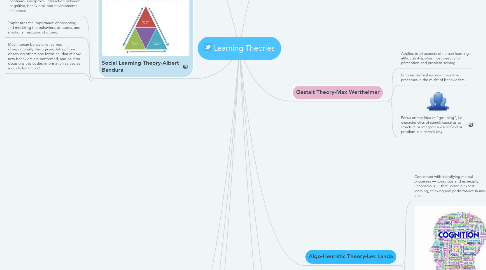Learning Theories
by Christina Crovetto


1. Constructivist Theory-Jerome Bruner
1.1. Learning is an active process in which learners construct new ideas or concepts based upon their current/past knowledge.
1.2. Curriculum should be organized in a spiral manner so that the student continually builds upon what they have already learned.
1.3. General framework for instruction based upon the study of cognition.
2. Social Learning Theory-Albert Bandura
2.1. Explains human behavior in terms of continuous reciprocal interaction between cognitive, behavioral, and environmental influences.
2.2. Emphasizes the importance of observing and modeling the behaviors, attitudes, and emotional reactions of others.
2.3. Most human behavior is learned observationally through modeling: from observing others one forms an idea of how new behaviors are performed, and on later occasions this coded information serves as a guide for action.”
3. Transformative Learning-Jack Mezirow
3.1. Two basic kinds of learning: instrumental and communicative learning.
3.2. Meaning structures (perspectives and schemes) are a major component. They are divided into 3 sets of codes: sociolinguistic codes, psychological codes, and epistemic codes.
3.3. Constructivist, an orientation which holds that the way learners interpret and reinterpret their sense experience is, central to making meaning and hence learning
4. Conditions of Learning-Robert Gagne
4.1. Learning tasks for intellectual skills can be organized in a hierarchy according to complexity: stimulus recognition, response generation, procedure following, use of terminology, discriminations, concept formation, rule application, and problem solving.
4.2. Five major categories of learning: verbal information, intellectual skills, cognitive strategies, motor skills and attitudes.
4.3. For cognitive strategies to be learned, there must be a chance to practice developing new solutions to problems; to learn attitudes, the learner must be exposed to a credible role model or persuasive arguments.
5. Multiple Intelligences-Howard Gardner
5.1. There are a number of distinct forms of intelligence that each individual possesses in varying degrees.
5.2. Learning/teaching should focus on the particular intelligences of each person.
5.3. The different intelligences represent not only different content domains but also learning modalities.
6. Social Development-Lev Vygotsky
6.1. Social interaction plays a fundamental role in the development of cognition.
6.2. The potential for cognitive development depends upon the “zone of proximal development.”
6.3. Vygotsky’s theory was an attempt to explain consciousness as the end product of socialization.
7. Gestalt Theory-Max Wertheimer
7.1. Applies to all aspects of human learning, although it applies most directly to perception and problem-solving.
7.2. Emphasizes higher-order cognitive processes in the midst of behaviorism.
7.3. Focus on the idea of “grouping”, i.e., characteristics of stimuli cause us to structure or interpret a visual field or problem in a certain way
8. Algo-Heuristic Theory-Lev Landa
8.1. Concerned with identifying mental processes — conscious and especially unconscious — that underlie expert learning, thinking and performance in any area.
8.2. All cognitive activities can be analyzed into operations of an algorithmic, semi-algorithmic, heuristic, or semi-heuristic nature.
8.3. Students ought to be taught not only knowledge but the algorithms and heuristics of experts as well. They also have to be taught how to discover algorithms and heuristics on their own.
9. Behaviorism-B.F. Skinner
9.1. Learning is a function of change in ovrt behavior.
9.2. Changes in behavior are the result of an individual’s response to events (stimuli) that occur in the environment.
9.3. Operant conditioning has been widely applied in clinical settings (i.e., behavior modification) as well as teaching (i.e., classroom management) and instructional development (e.g., programmed instruction).
10. Structural Learning Theory-Joseph Scandura
10.1. Learning is an active process in which learners construct new ideas or concepts based upon their current/past knowledge.
10.2. Structural learning prescribes teaching the simplest solution path for a problem and then teaching more complex paths until the entire rule has been mastered.
10.2.1. instruction

